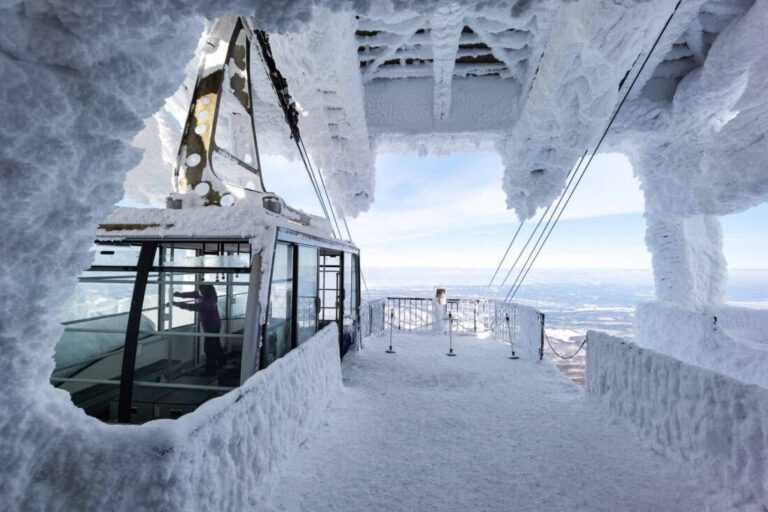When there are decent flight deals to Japan, they are often only available for the off-season. This typically means somewhere between December and March, when it’s too late for the autumn foliage but too early for (most) cherry blossoms. It’s not uncommon for comments to point out that this is not an ideal time to visit Japan.
This is true to some extent when looking at popular tourist destinations like Tokyo or Osaka. However, there are many good reasons to travel to Japan in winter that you might not necessarily be aware of. Whether you prefer trudging through meters of snow or hiking in tropical Okinawa: The country is so diverse that there’s something for everyone even in winter.
That’s why I’m eager to recommend such a trip as part of the Travel-Dealz recommends… series. Below are a few great reasons to visit Japan in winter.
Snowstorms and Snow Festivals in Hokkaido
I live in the far north of Germany and haven’t really experienced a proper winter in recent years. While it snows in the south, the winter in Rostock is usually grey and rainy with temperatures between 0 and 5 degrees Celsius. The days when the snow actually stays on the ground are few—yet I love snow!
One doesn’t even need to fly around the world to experience snow. A train ride or a short flight to Lapland is enough to guarantee snow. Still, I can’t help but feel happy seeing such a sight. Right after landing in Sapporo, I found myself in a heavy snowstorm, which even caused the Japanese trains to experience a few minutes of delay.



It’s also not like all of Japan goes into hibernation. On the contrary: While in medium-sized cities the sidewalks are rolled up at sunset, there are numerous festivals and events that run into the night during winter. These include, for example:
The largest of these is the Sapporo Snow Festival, which attracts over 2 million visitors each year. Here, you’ll find enormous snow sculptures in the middle of the city centre and a family-friendly amusement park with snow slides. The festival in Asahikawa is smaller but still impressive, with a huge snow castle. However, hotels should be booked early, especially in Sapporo, as many places are already sold out or overly expensive.




Snow Monsters in Tohoku
In addition to Hokkaido, the northwest of Honshu’s main island is also one of the snowiest regions in Japan. This includes the prefectures of Aomori, Akita, and Yamagata in the western part of the Tohoku region.
In addition to idyllic snowy landscapes, there’s a special highlight: Under specific weather conditions, snow monsters, or “juhyo” in Japanese, are formed. These are coniferous trees that accumulate a thick layer of ice, several centimetres deep, due to strong winds and frost. Anyone travelling to Tohoku between January and March has a great chance to see them up close.
The most famous of these snow monsters can be found on Mount Zao in Yamagata. Last winter, I visited Mount Moriyoshi (in the middle of nowhere) and the Hakkoda Mountains (1-hour bus ride from Aomori), and I really enjoyed the experience (detailed travel report in German). You can also reach these areas by public transport, but without a car, you’ll need to rely on the less frequent trains and buses.





For many, these snow sculptures may not be a reason to fly to Japan specifically. But for those who are already there: Don’t miss out!
Perfect Conditions for Skiing
For winter sports enthusiasts, Japan also offers great conditions. This is particularly appreciated by Australians. While Bali serves as a substitute for Mallorca, many flock to Japan for skiing. This is facilitated by the fact that a flight from e.g. Cairns only takes 7 hours, rather than the 12-hour flight from Europe. When I stayed at a hotel in a ski resort, I met only a handful of Japanese guests but over 20 from Australia. I was the only guest from Europe.
Japan is considered the best ski destination in Asia, offering more than 500 ski resorts. The prices for a ski day pass range from about €30 to €50, which is slightly cheaper than in Europe. However, at the adjacent restaurant, you can enjoy a bowl of ramen or a curry for less than JP¥1,000 (~€6). In Switzerland, I wouldn’t even get a portion of fries for that. And it’s also exciting to ski in a completely different culture.


By the way, the aforementioned snow monsters are often located right in the ski resort area and can be explored either directly from the slopes or through extensive off-piste tours (guide strongly recommended).
Summer Vibes in Okinawa
Still not convinced? Do you prefer to fly to the Canary Islands in winter to escape the European cold? Japan has an alternative for that as well. From Hokkaido, you can fly nearly 3,000 kilometres south and still be in the same country. The Okinawa islands enjoy temperatures ranging from 15 to 25 degrees Celsius even in winter. The most popular destinations are Okinawa and Ishigaki islands. However, there are many smaller islands with their own airports for those who prefer it quieter.
For swimming or snorkelling, it may be too cold for most in winter, as the water temperature is around 20°C. But for hiking, the weather is pleasant. On Tokashiki Island (a day trip from Naha), it was even too hot rather than too cold in February.



Other Reasons to Visit Japan in Winter
Here’s a colourful list of other reasons to travel to Japan in winter.
- In the remote northeast of Hokkaido (near Abashiri), you can take a boat tour through the drifting ice on an icebreaker. This is available from late January to late March.
- It’s also not necessarily too early for cherry and plum blossoms in winter. In Kawazu (a 3-hour train ride from Tokyo), a Cherry Blossom Festival takes place as early as February. Even in Tokyo, there are early cherry blossoms, and Okinawa has them as well. Additionally, the plum trees bloom beautifully during this time.
- As mentioned earlier, between December and March is the best chance for affordable flight tickets to Japan. From Europe, options are available for under €600, and even direct flights are reasonably priced. Almost all of our recent Japan deals applied (only) to the off-season. Hotels are often cheapest in winter and high summer (which is very hot), but this varies greatly depending on the destination and hotel.
- Admittedly, the early sunsets are a disadvantage for many activities. Even in Okinawa, it gets dark around 6 PM in winter, in Tokyo around 5 PM, and in Hokkaido even earlier. Personally, I enjoy the nighttime atmosphere in many Japanese cities more than during the day. The streets with neon signs and lanterns feel much more picturesque, and you don’t even notice that the trees have lost all their leaves.
As for the typical destinations of Osaka, Kyoto, and Tokyo in winter, I can’t say too much yet. The weather there seems rather uncomfortable with temperatures around 5 to 10 degrees, but there should be much less crowding compared to peak season. As a consolation: Winter has the fewest rainy days, so the chances of seeing Mount Fuji increase.

Conclusion
There are good reasons why winter is not the most popular travel time for a Japan trip. However, many factors also make visiting Japan during the off-season appealing. A preference for snow helps, but it’s not absolutely necessary.
Do you have any additional recommendations for a winter trip to Japan? Feel free to leave a comment.
Cover Picture: Peer Linder



